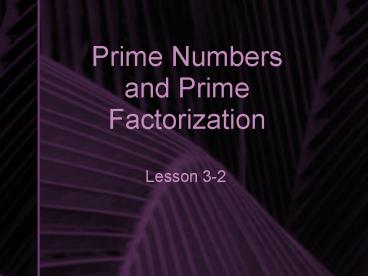Prime Numbers and Prime Factorization - PowerPoint PPT Presentation
1 / 17
Title:
Prime Numbers and Prime Factorization
Description:
Prime Numbers and Prime Factorization ... EXAMPLES: 6, 15, 18, 30, 100 A Product of Primes Every composite number can be expressed as a product of prime numbers. – PowerPoint PPT presentation
Number of Views:160
Avg rating:3.0/5.0
Title: Prime Numbers and Prime Factorization
1
Prime Numbers and Prime Factorization
- Lesson 3-2
2
Factors
- Factors are the numbers you multiply together to
get a product. - For example, the product 24 has several factors.
- 24 1 x 24
- 24 2 x 12
- 24 3 x 8
- 24 4 x 6
- SO, the factors are 1, 2, 3, 4, 6, 8, 12, 24
3
Finding Factors
- Start with 1 times the number.
- Try 2, 3, 4, etc.
- When you repeat your factors, cross out the
repeat - youre done at this point. - If you get doubles (such as 4 x 4), then youre
done. Repeats or doubles let you know youre
done.
4
What are the factors of 16?
1 x 16
2 x 8
3 x ??
3 is not a factor, so cross it out
4 x 4
doubles done
The factors of 16 are 1,2,4,8,16
5
What are the factors of 18?
1 x 18
The factors are 1,2,3,6,9,18
2 x 9
3 x 6
4 x ??
5 x ??
6 x 3
Repeat! Cross it out! Were done!
6
What are the factors of 7?
The only factors of 7 are 1,7
1 x 7
2 x ??
3 x ??
4 x ??
5 x ??
6 x ??
7 x 1
This works, but it is a repeat. We are done.
7
Prime and Composite Numbers
- Prime numbers are
- numbers that only have
- two factors one, and the
- number itself.
- EXAMPLES
- 3, 5, 7, 11, 31
- Composite numbers
- have more than two
- factors.
- EXAMPLES
- 6, 15, 18, 30, 100
8
A Product of Primes
- Every composite number can be expressed as a
product of prime numbers. - This is called prime factorization.
9
Example
- 15 is a composite number.
- It can be expressed as a product of primes 3 x 5
10
To find the prime factorization
- Divide the number by the first prime number
possible. - Circle the prime number, and continue with the
other factor. - Divide the new factor by a prime number.
- Continue this process until the only numbers you
have left are prime numbers.
11
Remember the Prime Number List
- 2, 3, 5, 7, 11, 13, 17, 19, 23, 29, 31, 37, 41,
43, 47, 53, 59, 61, 67, 71, 73, 79, 83, 89, 97
12
Example Prime Factorization of 100.
100
100 2 50. Two is the first prime number that
goes into 100.
Now we deal with the 50. Divide it by 2 to get
the next factors.
2 is a prime number, so we are done with it.
2 X 50
25 is not divisible by the first prime, 2. The
next prime, 3, does not work either. We must
divide by 5 to get a factor.
2 X 25
5 x 5
Both numbers are prime, leaving us with all
primes.
13
Whats the Answer?
- Now, we just list our factors with multiplication
signs between them. Use the circled prime
numbers. - 2 x 2 x 5 x 5
- We have listed 100 as a product of prime numbers.
14
Exponent Form
- We have just listed our prime factorization for
100 as being 2 x 2 x 5 x 5. This is repeated
multiplication. Repeated multiplication can be
expressed with exponents. - Our prime numbers are our bases. The number of
times the prime number is written is the
exponent. - 2 x 2 can be expressed in exponent form 22
- 5 x 5 can be expressed as 52
- Put it together, and 2 x 2 x 5 x 5 is more simply
put as - 22 x 52
15
Another Example
420
2 x 210
2 x 105
22 x 3 x 5 x 7
3 x 35
5 x 7
16
Try this on your own
54
Answer
2 x 33
17
Homework Time!































